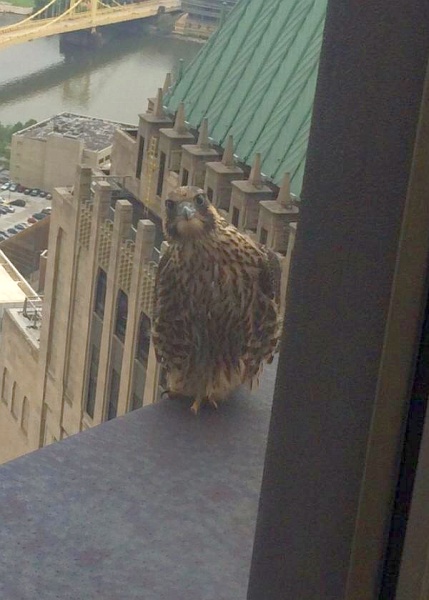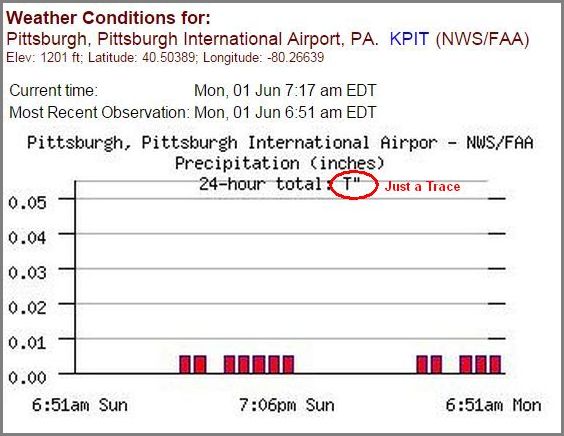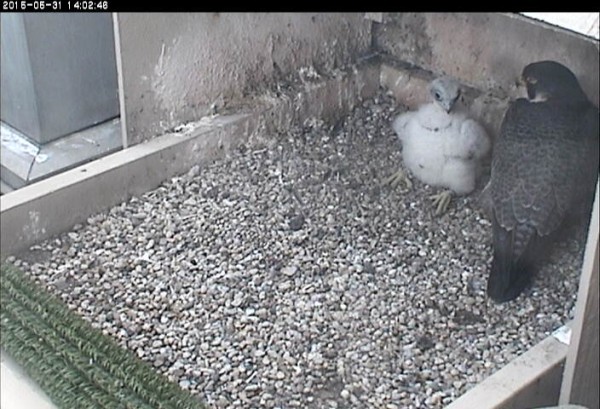
Now that peregrine nestlings have been examined and aged in the Pittsburgh area, we can estimate when each site will make its first flight.
The fledging dates below are just estimates, calculated as the 39th day after hatch(*). Young peregrines fly at 40-45 days old but the actual fledge date is up to the individual bird and sometimes the weather. Males fly earlier than females because their lighter weight makes it easy to get airborne. In a nest with both male and female chicks the youngest females are alone at the nest for a day or two after the males have left.
In Pittsburgh, point-based Fledge Watches are set for a day or two before expected fledge through at least the second day after the last bird has flown. Two days before flight it’s fun to watch the birds ledge-walk. Two days after fledge, young peregrines have enough strength and flight ability to move faster and further than Fledge Watchers can navigate, especially in Downtown Pittsburgh. At that point the official Fledge Watch dissolves while we wait for random reports of young peregrines peering in windows (nice to know) or accidents requiring rescue.
The table below shows the estimated dates. Note that end dates always depend on activity at the site.
| Nest Site | Nestlings | 39-day Estimated Fledge Date | Watch for accidents until… |
| Neville Island I-79 Bridge | 3 males, 1 female | 6/10/2015 (Actual: Two left bridge on 6/6) | 6/17 depending on activity |
| Downtown near corner of Fifth & Grant |
3 chicks, sex unknown, not banded | 6/14/2015 (Actual: 1st flew on 6/11) | 6/20 depending on activity |
| Cathedral of Learning at Pitt | 1 chick, sex unknown, development delayed by 5 days as of 5/29/15 |
6/18 or 6/23/15 due to unknown sex and delayed development (Actual: 6/21) |
2 Days after the chick fledges |
| Westinghouse Bridge | 2 chicks, sex unknown | 7/3/15 | 7/10 depending on activity |
Four of Pittsburgh’s eight peregrine nest sites have either no nesting activity or are a mystery this year.
- Mystery: Monaca, Beaver County. Nest site is inaccessible on top of the big black P&LE Railroad bridge that crosses the Ohio River from Monaca to Beaver.
- Mystery: McKees Rocks Bridge. Every year the peregrines’ nest is notoriously hard or impossible to find, even with a bucket truck. This spring an adult pair was seen on May 24 and the pair “kakked” at a kayaker on the Alcosan side of the river on May 31. It appears they have young but we have no idea where.
- No nest: Tarentum Bridge: This pair has not attempted to nest, perhaps because the male is young and still in juvenile plumage.
- No peregrines: Green Tree water tower. Nest was attempted in 2013. No peregrines this year.
(photo of a fledgling at the U.S.Steel Tower, June 2014 by Patti Mitsch)
(*) The official first-flight age is 40 days after hatch, but can appear to be 39 days when a bird hatches overnight.






